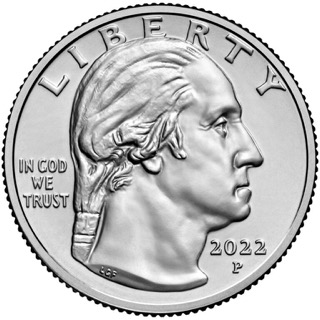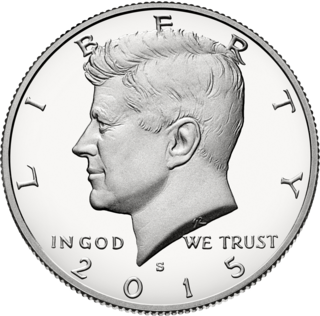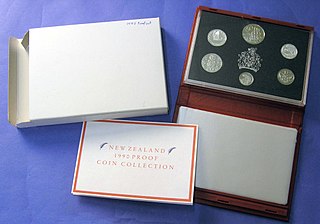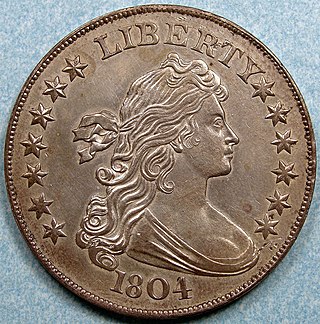A die defect is a unique and unintentional flaw in a coin die and is created through excessive use or polishing of the die. [1] A die bearing such a defect is occasionally referred to as a defective die. Generally, and depending upon the magnitude of the defect, coins that are produced from these dies are considered error coins. [2] Also, the term encompasses a wide variety of design errors that were engraved into the die originally and were slipped into circulation before the incorrect design was discovered.
A die crack occurs when a die, after being subjected to immense pressure during the minting process, cracks, causing a small gap in the die. [3] If this damaged die continues to produce coins, the metal will fill into the crack, thus revealing a raised line of metal in the finished coin. Specimens with more prominent die cracks can command a high premium and are valued greatly by some collectors. [4] However, less obvious errors are quite common, especially in the 50 States Commemorative Quarter Program, yielding a lower value. [5]
A cud on a coin is a damaged area resembling a blob at the edge of the coin. Cuds result from a piece of the perimeter of the die breaking away. They can be any shape depending on the shape of the piece that broke off the die. [6]

Coin collecting is the collecting of coins or other forms of minted legal tender. Coins of interest to collectors include beautiful, rare, and historically significant pieces. Collectors may be interested, for example, in complete sets of a particular design or denomination, coins that were in circulation for only a brief time, or coins with errors. Coin collecting can be differentiated from numismatics, in that the latter is the systematic study of currency as a whole, though the two disciplines are closely interlinked.

The quarter, short for quarter dollar, is a United States coin worth 25 cents, one-quarter of a dollar. The coin sports the profile of George Washington on its obverse, and after 1998 its reverse design has changed frequently. It has been produced on and off since 1796 and consistently since 1831.

Numismatics is the study or collection of currency, including coins, tokens, paper money, medals and related objects.

1943 steel cents are U.S. one-cent coins that were struck in steel due to wartime shortages of copper. The Philadelphia, Denver, and San Francisco mints each produced these 1943 Lincoln cents. The unique composition of the coin has led to various nicknames, such as wartime cent, steel war penny, zinc cent and steelie. The 1943 steel cent features the same Victor David Brenner design for the Lincoln cent which had been in use since 1909.
Mint-made errors occur when coins are made incorrectly at the mint, including anything that happens to the coin up until the completion of the minting process. Mint error coins can be the result of deterioration of the minting equipment, accidents or malfunctions during the minting process, or interventions by mint personnel. Coins are inspected during production and errors are typically caught. However, some are inadvertently released into circulation. Modern production methods eliminate many errors and automated counters are effective at removing error coins. Damage occurring later may sometime resemble true mint errors. Error coins may be of value to collectors depending on the rarity and condition. Some coin collectors specialize in error coins.

The half dollar, sometimes referred to as the half for short or 50-cent piece, is a United States coin worth 50 cents, or one half of a dollar. In both size and weight, it is the largest United States circulating coin currently produced, being 1.205 inches in diameter and 0.085 in (2.16 mm) in thickness, and is twice the weight of the quarter. The coin's design has undergone a number of changes throughout its history. Since 1964, the half dollar depicts the profile of President John F. Kennedy on the obverse and the seal of the president of the United States on the reverse.

The dollar coin is a United States coin with a face value of one United States dollar. Dollar coins have been minted in the United States in gold, silver, and base metal versions. Dollar coins were first minted in the United States in 1794.

The 50 State quarters was a series of circulating commemorative quarters released by the United States Mint. Minted from 1999 through 2008, they featured unique designs for each of the 50 US states on the reverse.

Proof coinage refers to special early samples of a coin issue, historically made for checking the dies and for archival purposes. Nowadays proofs are often struck in greater numbers specially for coin collectors (numismatists). Nearly all countries have issued proof coinage.

A double eagle is a gold coin of the United States with a denomination of $20. The coins are 34 mm × 2 mm and are made from a 90% gold and 10% copper alloy and have a total weight of 1.0750 troy ounces.

The 1955 doubled die cent is a die variety that occurred during production of the one cent coin at the United States Mint in 1955.

In numismatics, a mule is a coin or medal minted with obverse and reverse designs not normally seen on the same piece. These can be intentional or produced by error. This type of error is highly sought after by collectors, and examples can fetch high prices.
This glossary of numismatics is a list of definitions of terms and concepts relevant to numismatics and coin collecting, as well as sub-fields and related disciplines, with concise explanations for the beginner or professional.

"Draped Bust" was the name given to a design of United States coins. It appeared on much of the regular-issue copper and silver United States coinage, 1796–1807. It was designed by engraver Robert Scot.

Coin roll hunting is the hobby of searching and sorting coinage pulled from circulation for collectible coins. This is achieved through obtaining rolled coin, boxed coin, or bagged coin from banks and credit unions. A variant of this practice involves banknotes and is carried out in essentially the same fashion, normally to search for unusual serial numbers, star notes, and misprints.
The America the Beautiful quarters were a series of fifty-six 25-cent pieces (quarters) issued by the United States Mint, which began in 2010 and lasted until 2021. The obverse (front) of all the coins depicts George Washington in a modified version of the portrait used for the original 1932 Washington quarter. There were five new reverse (back) designs each year, each commemorating a national natural or historic site such as national parks, national historic sites, or national forests – one from each state, the federal district, and each territory. The program was authorized by the America's Beautiful National Parks Quarter Dollar Coin Act of 2008 (Pub. L.Tooltip Public Law 110–456 .
Minting, coining or coinage is the process of manufacturing coins using a kind of stamping, the process used in both hammered coinage and milled coinage. This "stamping" process is different from the method used in cast coinage.

The Sheldon Coin Grading Scale is a 70-point coin grading scale used in the numismatic assessment of a coin's quality. The American Numismatic Association based its Official ANA Grading Standards in large part on the Sheldon scale. The scale was created by William Herbert Sheldon.
US error coins are error coins produced by the US government. There are three categories of error coins as provided by the American Numismatic Association. Metal usage and striking errors referred to widely as planchet errors, die errors, and mint striking errors. This does not include the varieties that the US Mint has issued over the years.

The 1804 dollar or Bowed Liberty Dollar was a dollar coin struck by the United States Mint, of which fifteen specimens are currently known to exist. Though dated 1804, none were struck in that year; all were minted in the 1830s or later. They were first created for use in special proof coin sets used as diplomatic gifts during Edmund Roberts' trips to Siam and Muscat.